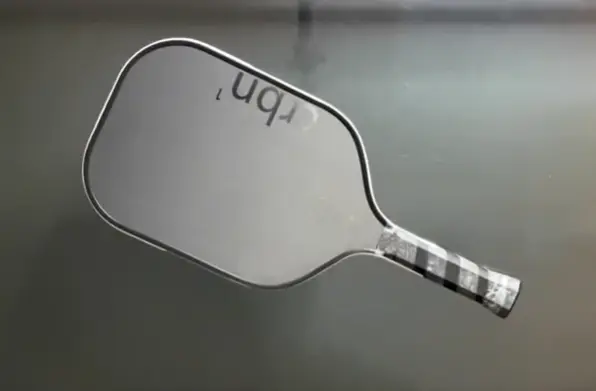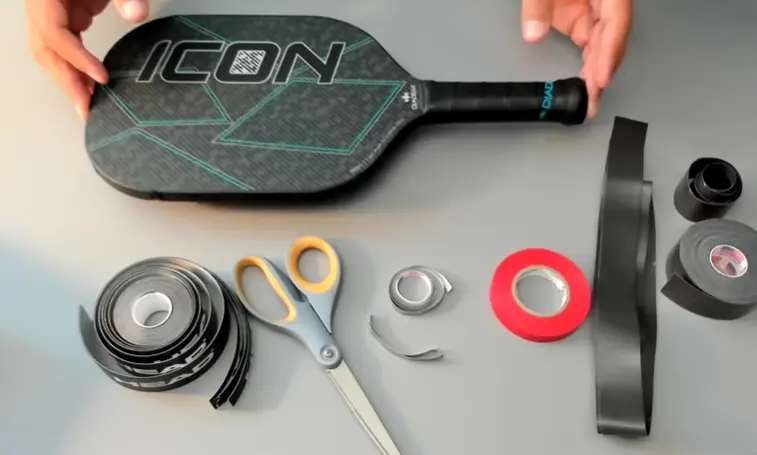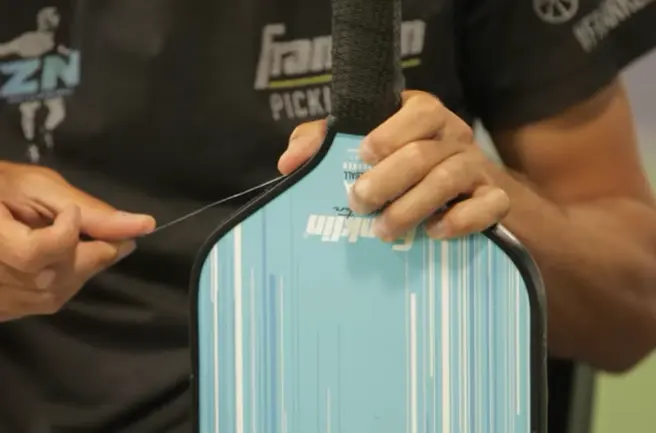If you’re an avid pickleball player, you’ll understand the importance of having the right equipment.
In addition to the paddle’s basic construction, there are other ways to enhance its performance, including adding lead tape to increase weight, power, stability, and grip.
However, did you know that texture can also be added to the handle and frame of your paddle? While this can help increase spin, it’s important to be aware of the strict rules governing the texture of pickleball paddles.
The USA Pickleball Association (USAPA) sets the standards for paddle construction and usage, and there are specific guidelines in place for adding texture to the surface of a pickleball paddle.
The roughness of the paddle must meet the USAPA standards, and the surface texture must adhere to certain rules to ensure that the paddle remains legal for play.
In this article, we’ll explore the different ways you can add texture to your pickleball paddle and how you can do so within the rules and regulations set out by the USAPA.
Whether you’re a new or intermediate player looking to enhance your game or an experienced player wanting to explore new ways to improve your performance, we’ve got you covered.
So, let’s dive in and explore how you can add texture to your pickleball paddle while staying within the guidelines set out by the USAPA.
How To Add Texture To Pickleball Paddle
The paddle is an essential piece of equipment in pickleball and can greatly impact your performance. It is therefore important to choose the right paddle to suit your needs and skill level.
One of the main reasons why the paddle is so important in pickleball is because it affects the way the ball is hit and the amount of control you have over the ball.
The weight, shape, size, and grip of the paddle can all impact the way you play the game. A heavier paddle, for example, can provide more power, but may be more difficult to maneuver quickly.
Do Not Forget to Read: What Is The Double Bounce Rule In Pickleball
Do Not Forget to Read: Latest Pickleball Paddles

On the other hand, a lighter paddle can be easier to control and maneuver, but may not provide as much power. It is important to find the right balance between power and control when choosing a paddle.
Additionally, the grip of the paddle can impact your comfort level and ability to hold the paddle for extended periods of time. Ultimately, the right paddle will help you improve your game and enjoy the sport to the fullest.
Can You Add Texture To The Pickleball Paddle?
In the game of pickleball, players are allowed to add texture to the handle and frame (edge guard) of the paddle. This means that players can change the surface of the paddle to improve their grip and control over the paddle.
However, there are some limitations on the type of texture that can be added to the paddle.
Adding Textures to the Paddle
The first limitation is that players can only add texture to the surface of the paddle if it does not change its roughness in any way. This means that the texture cannot be too abrasive or rough, as this could give the player an unfair advantage in the game.
The texture must also be evenly distributed across the surface of the paddle.
Adding texture to the paddle can be done in several ways. One of the most common ways is to add grip tape to the handle of the paddle. Grip tape is a thin, adhesive tape that is designed to improve grip and control.
It is often used in other racquet sports, such as tennis and badminton. Grip tape is available in a variety of colors and textures, allowing players to customize their paddle to their liking.
Do Not Forget to Read: Best Pickleball Paddles for Tennis Players
Rules and Regulations Regarding Pickleball Paddle Textures:
The United States of America Pickleball Association (USAPA) is the governing body for the sport of pickleball in the USA. The USAPA has strict rules and regulations regarding the materials and textures of pickleball paddles.
According to the USAPA rules, a pickleball paddle can be made from any material that is legal, safe, and durable.
However, the paddle must meet certain size and weight restrictions. The paddle’s width cannot exceed 8.25 inches, and its length cannot exceed 17 inches. The weight of the paddle cannot exceed 14 ounces.
The USAPA also has rules regarding the texture of the pickleball paddle. The paddle must have a smooth surface with no paint texture or sand.
The USAPA prohibits the use of any materials that can alter the ball’s trajectory or spin, such as rubber, vinyl, or any other materials that can affect the ball’s flight.
The use of sandpaper on the paddle’s surface is also prohibited. These rules are designed to ensure that all players have an equal opportunity to hit the ball and that no player gains an unfair advantage through the use of textured paddles.
Suitable Materials and Textures for Tournament Play:
The most common materials used to make pickleball paddles are wood, composite materials, and graphite. Wood paddles are inexpensive and lightweight, but they are not as durable as composite or graphite paddles.
Composite paddles are made from a combination of materials such as fiberglass, carbon fiber, and Kevlar. These paddles are more durable than wood paddles and offer better control and power.
Graphite paddles are the most expensive but are also the lightest and most durable. They provide the best control and power, making them popular among professional players.
When it comes to textures, the USAPA rules require that the paddle’s surface is smooth, with no paint texture or sand. However, the USAPA does allow for certain textures on the paddle’s surface, such as a slightly rough or gritty texture.
These textures can provide better grip and control of the ball, but they must not alter the ball’s trajectory or spin in any way.
Limited Ways to Modify the Pickleball Paddle:
Players are allowed to modify their pickleball paddles to a limited extent, but they must follow the USAPA rules regarding modifications. The USAPA allows players to add grip wraps, lead tape on the paddle edge, or replace the paddle grip.
However, no removable parts are allowed, and players cannot make any modifications that alter the paddle’s weight or balance.
Springs or materials that could create a trampoline effect are also prohibited. Electrical, electronic, or mechanical alterations of any sort are strictly prohibited.
Do Not Forget to Read: Best Pickleball Paddles for Tennis Elbow
Butt of the Paddle
The paddle’s handle or butt is the part that the player holds, and it can be customized with lead tape to improve hand speed, stability, and grip. Additionally, adding textures to the paddle’s butt can enhance its grip and feel.
Adding Lead Tape To The Butt Can Improve Hand Speed
Lead tape is a thin strip of metal that is used to add weight to objects such as golf clubs, fishing rods, or pickleball paddles.

The added weight can improve the object’s balance, power, and control. In pickleball, adding lead tape to the handle or butt of the paddle can make it easier to maneuver, especially in the kitchen or on the no-volley zone line.
The kitchen is the area close to the net where players need to perform delicate shots and volleys, and having a stable and responsive paddle can make a difference in winning or losing points.
One of the benefits of using lead tape on the butt of the paddle is that it can improve hand speed. When the paddle’s weight is distributed evenly, the player can swing it more quickly and with less effort.
This can help generate more power and accuracy in shots, especially in the backhand or overhead positions. Additionally, the added weight can increase stability, making the paddle less prone to twisting or turning during play.
This can enhance the player’s confidence and control, leading to better shot selection and execution.
Do Not Forget to Read: Do Pickleball Paddles Wear Out?
How To Wrap Lead Tape Around The Handle Or Butt
To apply lead tape to the paddle’s handle or butt, one needs to start by cleaning the surface and drying it thoroughly. Then, cut a strip of lead tape that is about 12 inches long, and wrap it around the handle or butt in spirals.

It is recommended to start from the bottom and work your way up, overlapping the edges slightly to create a seamless layer. Avoid covering the grip entirely, as this can make it too bulky and uncomfortable to hold.
It is also essential to use lead tape that does not become too slippery during play, as this can reduce grip and precision.

Special Tape Made For Pickleball Paddles
Another option to improve the paddle’s grip and feel is to add textures to the butt. Textures are patterns or grooves that provide extra traction and feedback to the player’s hand.
They can be created by sanding or etching the surface, or by applying a textured tape.
Textured tapes are specially designed for pickleball paddles, and they come in different colors and patterns. They are easy to apply and remove, and they can add a personalized touch to the paddle’s appearance.
Adding Weight to the Paddle Frame
The weight of the paddle can vary based on the materials used, which can affect the player’s performance.
If the paddle is too light, it may not have enough power, and if it’s too heavy, it may be challenging to maneuver. In such cases, adding weight to the paddle frame with lead tape can be a game-changer.
Lead tape increases the weight of the paddle, making it more stable and powerful. However, before adding the lead tape to the paddle frame, it is essential to know where to apply it to get the desired results.
Where To Add The Tape On The Paddle Frame
The ideal place to add lead tape to the paddle frame is just above the handle in the right-hand corner (4-5 o’clock) and left-hand corner (7-8 o’clock).
These areas are the best spots to add weight to improve stability and balance. The added weight in these areas will create a better energy transfer, leading to a more powerful hit.

Moreover, the additional weight will also help absorb shock, resulting in less vibration when striking the ball.
If more power is desired, lead tape can also be added to the top frame of the paddle (10 o’clock and 2 o’clock). Adding lead tape to these areas will help increase the power and stability of the paddle. It will also help the energy transfer between the ball and the paddle, resulting in more powerful hits.
Adding Lead Tape To The Paddle Frame Can Improve Power
Adding lead tape to the whole frame of the paddle is also an option to increase weight, power, and speed. However, adding too much weight can also make the paddle difficult to maneuver.
It’s important to experiment with different weights and paddle configurations to find the perfect balance for your playing style.
Balancing the weight of the paddle is also important. It can be achieved by adding lead tape to the top and bottom of the paddle.
Balancing the weight will make the paddle more stable and easier to control. It will also improve the player’s shot accuracy and help with maneuvering the paddle.
Benefits Of A Heavier Paddle Swing
Professional pickleball players often use lead tape to add weight and stability to their paddles. The added stability from lead tape can help defend against power swings from opponents.
Adding weight to the paddle frame can also increase the lifespan of the paddle by reducing the amount of shock that the paddle endures during play.
Do Not Forget to Read: Best Pickleball Party Ideas
Frequently Asked Questions:
Conclusion
Adding texture to a pickleball paddle can be a great way to improve grip and handling, as long as it’s done within the allowed modifications outlined by the USAPA and IFP.
These include adding weight, improving grip, and adding drawings/pictures in good taste. However, it’s important to note that the surface of the paddle should not be altered in any way other than allowed changes.
Additionally, adding texture for the sake of it is not recommended. It’s crucial to check if the modification actually improves the paddle’s handling before making any changes.
Remember, the only allowed modifications to grip size or wrap are adding lead or electrical tape to the edge guard or handle. Adding any substance for reasons other than mentioned above is illegal and prohibited.
It’s recommended to check the rule book for further details or updates before making any modifications to the paddle.

Michael Stevenson
Hi, my name is Michael Stevenson and I’m a passionate pickleball player. I’ve been playing the game for many years and I’m pretty highly skilled at it. Pickleball is one of my favorite topics so naturally, I love to write about it.
Whether it’s tips for beginners, guides for experts, reviews of new paddles, or advanced playing techniques – if it relates to pickleball then I have something interesting to write about it. So if you’re looking for entertaining and informative information on the topic of pickleball, look no further than my written works!